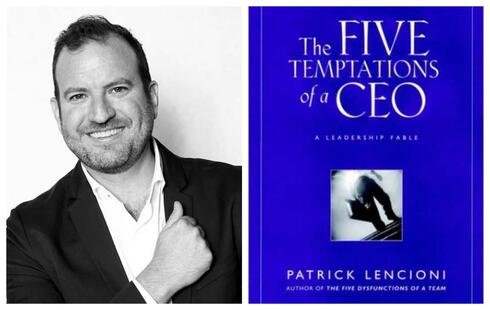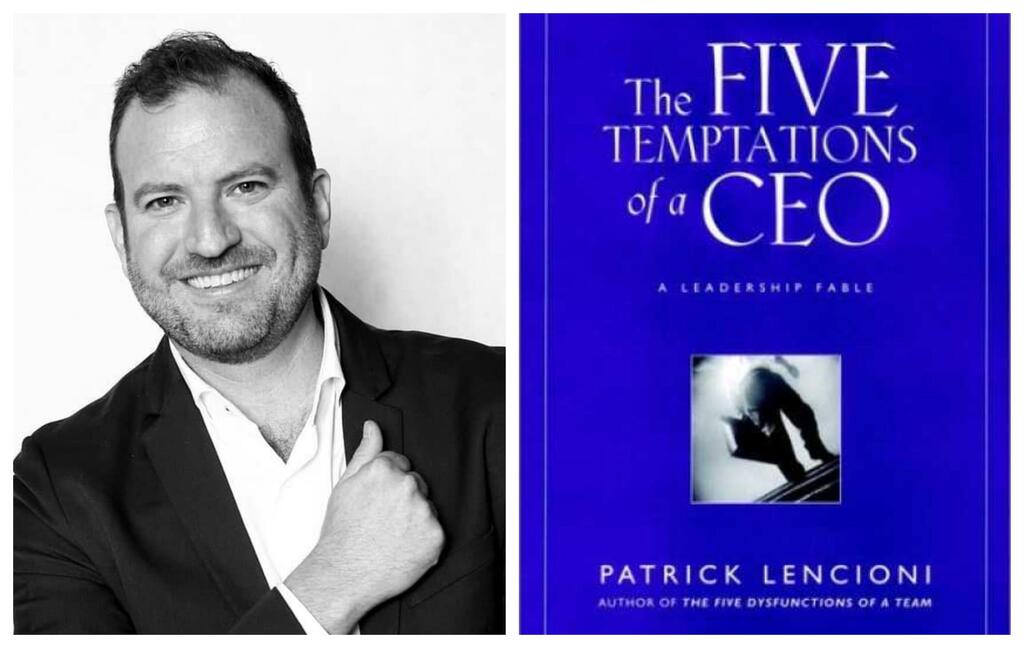
BiblioTech
CTech’s Book Review: Assessing five temptations that CEOs might face
Eze Vidra, Managing Partner, Remagine Ventures, shares insights after reading "The Five Temptations of a CEO” by Patrick Lencioni
Title: "The Five Temptations of a CEO”
Author: Patrick Lencioni
Format: Book
Where: Home
Summary:
This is a management book told in the form of a fable/story. The main character, Andrew, is about to celebrate his first year anniversary as the CEO of a company where he worked for a number of years. He’s stressed about the upcoming board meeting, as the company has been struggling. On a train ride home, he’s ‘enlightened’ in a conversation with a passenger (Charlie) who makes him understand that being a CEO might be challenging, but it shouldn’t be complicated. The book is packed with actionable insights and advice for company leaders.
Important Themes:
The book centers around the Five temptations of the CEO as core themes:
Temptation 1: Ego over Results
When asked to describe his proudest professional moment, the CEO said that it was the moment he was appointed after years of hard work. But a title, even if it was the result of hard work, shouldn’t be the goal. It should be achieving something, ideally as a team. A strategy for overcoming this temptation is to publicly commit to results and evaluate success based on results.
Temptation 2: Popularity over Accountability
Communicating expectations up front and having discussions about performance can be hard and many would choose to avoid tough conversations or conflict with direct reports. But the goal should be to empower your team to be accountable because they know clearly what's expected of them.
Temptation 3: Certainty over Clarity
CEOs need to make many decisions under uncertainty. While it's tempting to postpone a decision and wait for clarity in order not to make the wrong choice, it can lead to leaving the team in limbo. The advice to the CEO is to take the risk that some decisions may be wrong but give the team clarity. It is a concept ex-military commanders are probably very familiar with.
Temptation 4: Harmony over Conflict
To make good decisions, a leader must be able to extract the true opinions of her team, even if it means creating tension or disagreement, what the author calls 'productive conflict'. The advice to the CEO is to tolerate discord and encourage passionate discussion and exchanges of ideas.
Steve Jobs and Jeff Bezos are known for creating this tension in meetings and getting their management teams to speak up. Ray Dalio, the billionaire hedge fund manager and founder of Bridgewater Associates took this to the extreme by promoting “radical transparency” in the team.
Temptation 5: Invulnerability over Trust
If the CEO maintains a facade of invulnerability, it may lead to her direct reports wanting to do the same, stopping them from sharing their own views and ideas. Vulnerability leads to trust. Being vulnerable is not something you’d expect to see in the job description for the CEO role, but it's an essential leadership tool. The advice to the CEO is to be approachable and open.
What I’ve Learned:
To be successful, CEOs need first and foremost to be good human beings. Business is personal. CEOs are most successful when they are able to create strong performing teams. The CEO’s role is very much about providing direction and listening to people to make the best decisions they can under imperfect information.
Results over ego is another important lesson. A good day on the job is a day where the team achieved results, not when you get the title. For me, as a VC investor working closely with a number of startup CEOs, it was a reminder that success is often best measured in the day-to-day grind, when startups build effective teams and ship products that customers are willing to pay for (with time or money), not necessarily in the founding announcements that we see in the press.
Critiques:
It's hard to do justice to a big topic like leadership or 'how to be a good CEO' in a 150-page book told as a fable. Business books tend to be 150 pages because publishers found the ‘thickness’ people expect to have in a book to assign it value and justify the cost, but in reality, you could usually summarise the concept in 15 pages, and the rest is filler content and examples. But while The Five Temptations of a CEO was a ‘skinny’ book and the principles are communicated as a fable, but they make a fun, quick read despite having a deeper message.
Who Should Read This Book:
I highly recommend this to founders and emerging managers. I first found out about it from a podcast, where Peter Fenton, a partner at Benchmark, mentioned that he gifts this book to every CEO in his portfolio. I've since recommended it to many founders and got positive feedback from them. In addition, I recommend Lencioni's sequel book, "The Five Dysfunctions of a Team" which moves from the individual leader to managing team dynamics and culture. For what it's worth, I finished both books in about 48 hours!














